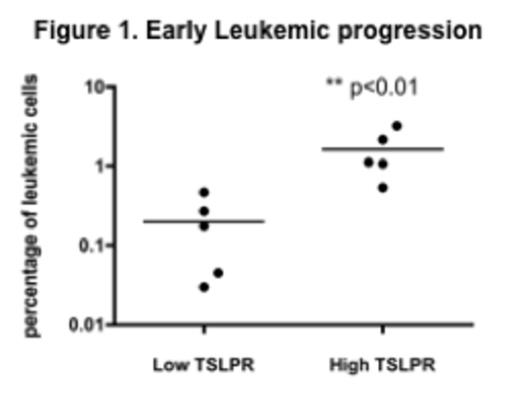Abstract
Pediatric acute lymphoblastic leukemia (ALL) is the most common childhood malignancy. Although the cure rate for this disease is greater than 85%, ALL remains the number one cause of cancer-related deaths in children due to relapse of ALL. Therefore, there is a great need to identify new therapies for patients who have recurrent disease. Recently, a subset of pediatric ALL patients whose leukemic cells express high levels of thymic stromal lymphopoietin receptor (TSLPR/CRLF2) have been shown to have an increased risk of relapse and shorter disease free and poorer overall survival. Overexpression of TLSPR occurs in 8% of unscreened pediatric precursor B ALL and occurs by genomic rearrangement of the TSLPR gene, which fuses the unmutated TSLPR gene to altered transcriptional control or by other yet to be described means. The mechanism by which Thymic Stromal Lymphopoietin (TLSP) signaling contributes to increased risk of relapse is unknown. Studies have shown aberrant signaling in high TSLPR expressing ALL patient derived cell lines relying heavily on in vitro experiments. As no pre-clinical model of high TSLPR ALL has been published, we created a model of high TSLPR expressing leukemia to study TSLPR overexpressing leukemia progression. We have created a high TSLPR expressing leukemia cell line through retroviral transduction of a transplantable syngeneic mouse leukemia model in which the leukemic progression can be studied with physiologic levels of TSLP. This high TSLPR leukemia has levels of expression of TSLPR comparable to what is found on human leukemia that overexpress TSLPR. The TSLPR is functional in these cells and we see increased phosphorylation of STAT5 protein in response to IL-7 or TSLP stimulation. When we introduce the leukemia into mice and look at disease progression, we observed an 8 fold difference in the numbers of cells in the bone marrow 5 days after intravenous injection corresponding to an early stage of leukemia progression (Figure 1. high TSLPR 1.61%+/-0.95 vs. low TSLPR 0.20%+/-0.16). Interestingly we find no significant difference in long term survival of mice injected with either low or high TSLPR leukemia lines. The increased numbers of leukemic cells in the bone marrow at early stages of leukemic progression could be due to an increased rate of proliferation or better survival/engraftment. Low and high TSLPR expressing cells show no significant difference in growth rate in vitro or in vivo in dye dilution assays (Figure 2) suggesting that the increase in leukemic cells in the bone marrow is through enhanced survival. To test this, we treated low and high TSLPR leukemia lines with the steroid dexamethasone in the absence or presence of TSLP. We found that the addition of TSLP significantly reduced the Annexin V positive relative to cells not treated with TSLP in the high TSLP expressing leukemia cells, while in low TSLPR expressing cells we observed no decrease in Annexin V positive cells (Figure 3). This suggests that high TSLPR expression sensitizes leukemia cells to TSLP in the leukemia microenvironment. To confirm that this is the case we have found by gene expression analysis that we can detect TSLP in mouse bone marrow. We hypothesize that therapies targeting the TSLP signaling axis in ALL would decrease the risk of relapse. To test this hypothesis we have generated TSLPR-Fc conjugates to block TSLP signaling. We plan on using these reagents to block TSLP signaling to see if we can reverse the increased amounts of leukemia we find in mice at early stages of leukemic progression as well as the eliminate the survival advantage provided by TSLP to high TSLPR expressing leukemic cells in response to chemotherapeutic agents.
Disclosures:
No relevant conflicts of interest to declare.
Author notes
*
Asterisk with author names denotes non-ASH members.
© 2013 by The American Society of Hematology
2013




This feature is available to Subscribers Only
Sign In or Create an Account Close Modal